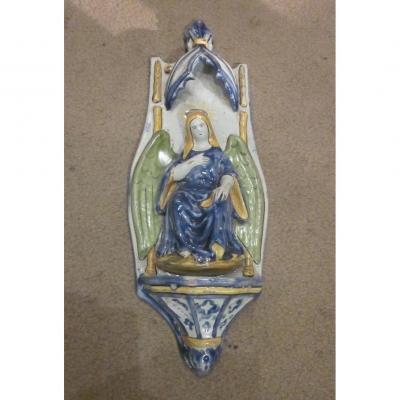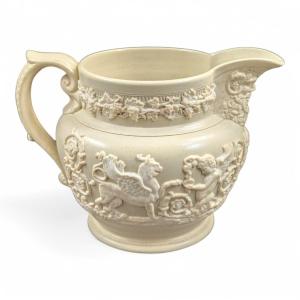"Rare Ridgway Drabware Stoneware Jug, Bacchus, Griffins And Amphora Decoration, C 1808"
Rare Ridgway Drabware 'Dutch' Jug with Bacchus Spout and Sprigged Griffins, Cherubs, and Amphora, Staffordshire, circa 1808A rare and finely crafted antique stoneware jug, made by Job Ridgway & Sons of Cauldon Place, Shelton, Staffordshire, circa 1808. This elegant Regency-period piece is crafted in buff-coloured drabware with smear-glazed exterior and fully glazed interior.The jug is richly decorated with finely detailed sprigged scenes, including griffins, cherubs, and scrolling vines laden with clusters of grapes. A grapevine frieze encircles the body just below the rim, executed in fine relief. The spout is modelled as the head of Bacchus, the Roman god of wine and festivity, adorned with a luxuriant beard and a crown of grapevines heavy with fruit. On the front of the jug, a large classical amphora is incorporated into the design, framed by elaborate scrollwork and flanked by mythological figures. All decorative elements were carefully moulded from cream clay and applied by hand before firing, using the sprigging technique typical of early 19th-century stoneware artistry.The 'Dutch' jug shape was introduced in the early 19th century and became a favourite among pottery and porcelain manufacturers. The decorative frieze on this jug is inspired by a classical design from "Etchings Representing the Best Examples of Ancient Ornamental Architecture," published by C.H. Tatham in 1803.This example is particularly rare. While the Victoria and Albert Museum holds a similar jug made by John and William Ridgway, this specimen was produced by Job Ridgway & Sons, making it an even rarer and highly collectible piece. The base is marked with pattern number 35.
Historical BackgroundThe Ridgway family played a significant role in Staffordshire's ceramic history, rising to prominence in the early 19th century. Drabware, with its subdued buff tones, was fashionable during the Regency period, alongside other ground colours like mint green, purplish red, and ginger. Stoneware’s durability and capacity for intricate applied decoration made it highly popular for functional yet decorative wares.
MeasurementsHeight: 11 cm / 4.33″Width: 16 cm / 6.30″Depth: 11 cm / 4.33″Weight: 280 gConditionExcellent antique condition for its age. The sprigged decoration remains crisp and finely detailed. The smear glaze retains an attractive satin sheen with soft antique patina. There is a small chip to the bottom rim, as visible in the photographs, but it is discreet and does not detract from display. No other cracks, repairs, or restorations noted. A rare and exceptional example of early 19th-century Staffordshire stoneware.
Shipping & PackagingFully tracked and insured delivery.Shipping cost includes professional packaging, careful handling, and postage.Carefully packed using recycled materials where possible.Customs paperwork provided where necessary for smooth international delivery.Please review all photographs carefully, as they form part of the description, and feel free to ask any questions.






























 Le Magazine de PROANTIC
Le Magazine de PROANTIC TRÉSORS Magazine
TRÉSORS Magazine Rivista Artiquariato
Rivista Artiquariato
